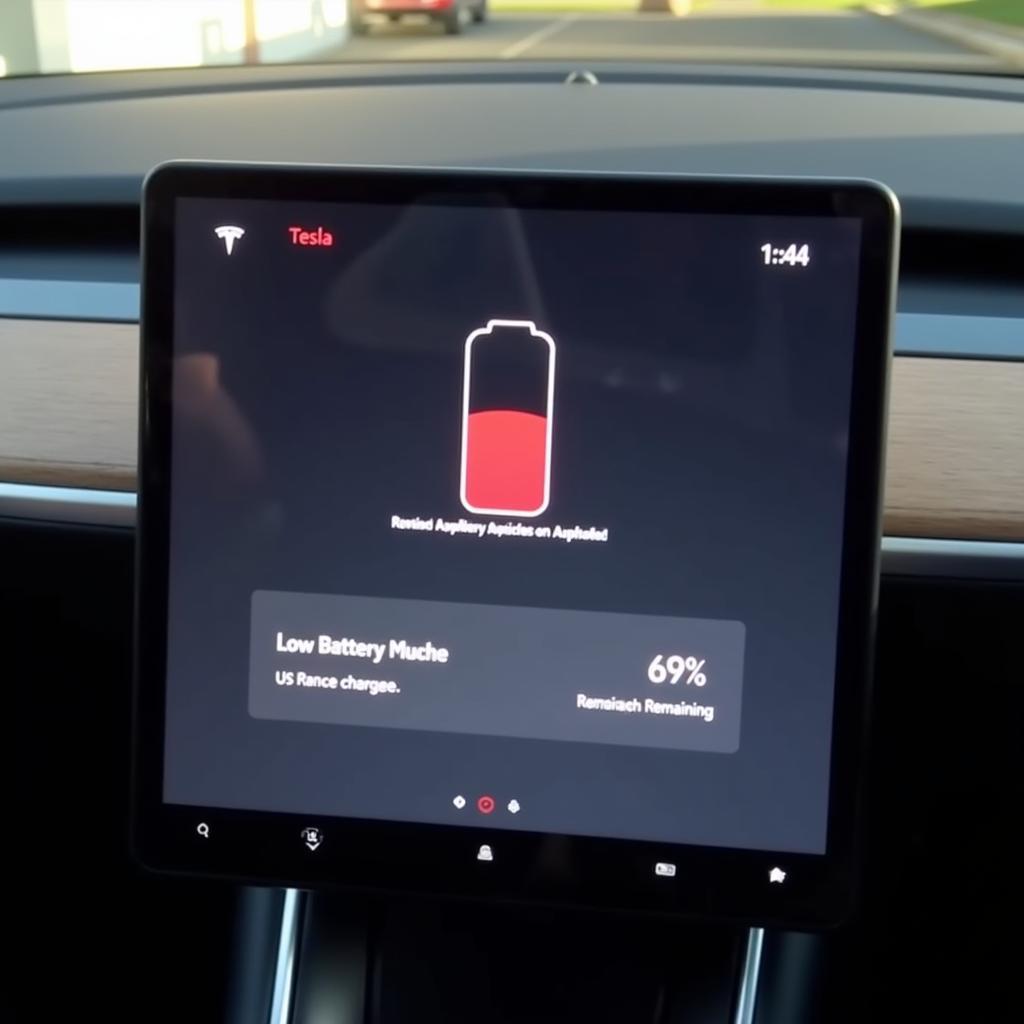Tesla battery warnings can be a source of anxiety for owners. These warnings can range from minor notifications to more serious alerts, indicating a potential problem that needs attention. Understanding the different types of Tesla battery warnings and how to troubleshoot them can help you keep your electric vehicle running smoothly.
Similar to the issues discussed in tesla model 3 brake warning light, battery warnings are often displayed on the touchscreen and may be accompanied by audible alerts. These warnings serve as an early indication of potential issues, allowing you to address them proactively. Ignoring these warnings can lead to more serious problems, impacting the performance and longevity of your Tesla’s battery.
Types of Tesla Battery Warnings
Tesla vehicles utilize sophisticated battery management systems that constantly monitor various parameters, including temperature, voltage, and current. When a parameter falls outside the acceptable range, the system triggers a warning. Common Tesla battery warnings include:
- Low Battery Warning: This is the most frequent warning and simply indicates that the battery charge is low and needs recharging.
- Temperature Warning: Extreme temperatures, both hot and cold, can affect battery performance. A temperature warning indicates the battery is outside its optimal operating temperature range.
- Cell Imbalance Warning: This warning indicates an uneven distribution of charge across the individual battery cells.
- Battery Degradation Warning: Over time, all batteries degrade and lose capacity. This warning may indicate significant battery degradation requiring further investigation.
- Maximum Power Reduced Warning: This warning is often associated with temperature issues or other battery problems, and indicates the vehicle’s power output is limited to protect the battery.
 Tesla Battery Warning: Low Battery Indicator on Touchscreen
Tesla Battery Warning: Low Battery Indicator on Touchscreen
Troubleshooting Tesla Battery Warnings
Many Tesla battery warnings can be resolved with simple troubleshooting steps. If you encounter a warning, consider the following:
- Check the Touchscreen: The touchscreen provides detailed information about the warning and often suggests corrective actions.
- Recharge the Battery: If the warning is related to low battery charge, connect your Tesla to a charger.
- Adjust the Climate Control: Temperature warnings can often be addressed by preconditioning the battery, either through the Tesla app or the vehicle’s climate control system.
- Check for Software Updates: Tesla regularly releases over-the-air software updates that can address battery-related issues. Ensure your vehicle has the latest software installed.
- Contact Tesla Service: If the warning persists or becomes more frequent, contact Tesla Service for professional diagnosis and repair.
Just as with the tesla brake warning light, addressing battery warnings promptly can prevent further issues and ensure optimal vehicle performance. Regular maintenance and proper charging practices can also help extend the life of your Tesla battery.
What Causes a Tesla Battery Warning?
A Tesla battery warning can be triggered by a variety of factors, ranging from simple user errors to more complex underlying problems. Some common causes include:
- Low State of Charge: Simply driving the vehicle until the battery is nearly depleted.
- Extreme Temperatures: Exposing the battery to very hot or cold temperatures.
- Rapid Charging: Frequent use of Superchargers can contribute to faster battery degradation, potentially leading to warnings.
- Software Glitches: Occasionally, a software bug can trigger a false warning.
- Hardware Issues: In some cases, a warning may indicate a problem with the battery pack itself.
How to Prevent Tesla Battery Warnings
Proactive measures can significantly reduce the frequency of Tesla battery warnings. Here are some tips:
- Maintain Proper Charging Habits: Avoid regularly charging to 100% or letting the battery discharge completely. Aim for a charge level between 20% and 80% for daily use.
- Precondition the Battery: In extreme temperatures, preconditioning the battery can optimize its performance and prevent warnings.
- Keep Your Software Up-to-Date: Install the latest software updates to ensure your battery management system is functioning correctly.
- Drive Conservatively: Aggressive driving can put additional strain on the battery, potentially leading to warnings.
- Schedule Regular Service: Routine maintenance checks by Tesla Service can help identify potential battery issues early on.
Understanding the air bag and seat belt warning light is crucial for safety, but maintaining battery health is equally important for performance and longevity.
Conclusion
Tesla battery warnings are designed to alert you to potential issues with your vehicle’s battery system. While some warnings are easily resolved, others may require professional attention. By understanding the different types of warnings, troubleshooting methods, and preventive measures, you can maximize the performance and lifespan of your Tesla battery. If you are uncertain about a battery warning, contacting Tesla Service is always the best course of action.
Similar to instances involving the 2018 tesla model s brake warnings, seeking professional assistance is crucial when troubleshooting complex issues. While some problems can be resolved independently, certain situations necessitate the expertise of qualified technicians. Consulting with Tesla service ensures access to specialized knowledge and tools, optimizing the chances of a successful resolution. This proactive approach can prevent further complications and maintain the vehicle’s performance. Don’t hesitate to reach out to Tesla Service when dealing with persistent or complex warnings.
Just like understanding the skoda octavia brake fluid warning light is essential for safe braking, monitoring and addressing Tesla battery warnings are crucial for optimal battery performance and vehicle longevity. By staying informed and proactive, you can contribute to a smoother and more reliable driving experience.
